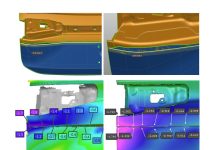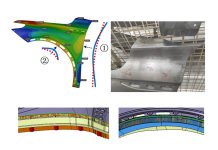What if there was a way to no longer miss any steps?
One year ago, Karan Bhise from AutoForm gave us his article: “What is a Healthy Simulation?”. It discussed the importance of ensuring real parameters as input and boundaries so that one never overlooks any of the important steps during simulation setup. This is a precursor to achieving greater accuracy for your engineering results! Now, in part two of this series, Karan examines new ways in which engineers can cross-examine their work by employing a “Guidelines Functionality”, which checks-off your work as you complete each step!
We at AutoForm believe that you work very hard to run accurate simulations and we consider it our job to make things easier for our customers to report results in a professional way.

A major point we emphasize is that setting up a “healthy simulation” should be a precursor to evaluating any result. This involves confirming that all inputs in the simulation match the reality of the press, that the simulation itself follows all company standards and has no warnings or error messages that might lead to results being untrustworthy.
Here is our recommended seven point “check policy” to determine if a simulation has been set up in a healthy way and is acceptable. These points apply to any CAE engineering process, no matter what brand of software you use:
- Check any warning and error messages in the solver warning monitor.
- Check settings for conformity with your company’s accepted standards.
- Ensure the modeling of process for the real die condition and design intent, which involves ensuring all simulation inputs match the shop floor conditions.
- Get a first impression of the entire process; go over the sheet results from start to finish to see if there are any noticeable issues.
- Check the analysis of the blank sag after gravity.
- Check the analysis of binder closing for wrinkles or excessive plastic strain.
- Check the analysis of punch impact to spot any irregularities on the sheet metal.
These seven points help users of any CAE engineering software validate the correctness and accuracy of the setup, so users can move on to evaluate the actual results. To facilitate an easier way to track simulation setup progress, we have always used the Left–to-Right, Top-to-Bottom approach. And now, in order to further make this process even easier for all users across the board, we’ve been investigating how to include a “checklist” in our software so that there is more consistency, nothing is ever missed and two simulations are comparable.
After all, you don’t want your colleagues to be examining your results while you might be thinking, “Did I remember to check that box during the setup?” or “Did I make sure that was loaded?”.
First of all, with AutoForm R5, several types of Standards have been introduced, which allow users to predefine settings within the user interface. However, we realized that there needed to be an additional guide to remember common use cases, workflows, etc. This is now solved by the new Guidelines functionality that was introduced with AutoForm Forming R8 and appears in your screen as you work on setting up your simulation.
The Guidelines Functionality: What every CAE engineering software should have!
The “Guidelines” functionality is something new and unique to AutoForm. It lets a company build their own checklist, which serves to work alongside the user to validate the inputs in the simulation during the setup. This includes surfaces imported, material files, tools and tool kinematics, as well as any company and/or construction standards.
In fact, you can simply start by using one of our predefined Guidelines for different planning phases or edit an existing guideline from our software’s library to best suit your needs. The provided detailed Guideline templates cover use cases such as Cost Engineering, Final Stamping Simulation and so on.
To give you an impression, picture a live checklist, situated on the left of your screen, which monitors your work, turning red signals into green as every step is completed during the setup. The Guideline will display red markers emphasizing any missed inputs.
The checklist can have either of these two types of pointers:
- Automatic checkpoints (Fig. 1) which look for specific locations for inputs. These can be used for inputs like standard files and bead specifications, which correspond to the company standard and need to be set automatically for all simulations. This checkpoint stays red until the mapped input is added to the simulation. Once the required input has been added to the simulation, the pointer turns green. If any input is intentionally chosen to be skipped, the users can choose the ‘Accept Anyway’ option.
- Manual input checkpoints (Fig. 2) which the user must activate with a green or red color, suggesting whether the parameter/condition is satisfied in the simulation or missing. Such an input is used to check items for verification of parameters such as using updated part geometry, checking for tipping, coordinate systems, symmetry and so on. If this button is left blank, it could suggest that the user may have missed this check.
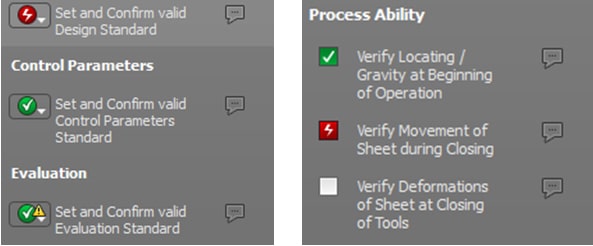
Fig. 1 & Fig. 2
In addition to our checkpoints, the Guidelines functionality has two additional features:
- The Guidelines function provides an option to take a screenshot and add a comment associated with any of the checkpoints. This helps bring attention to any hot spots, geometry issues or any other issues on the part or tool geometry which might not have been reported otherwise.
- Users can print this checklist as a precursor to validate simulation results. This report is stored in PDF format, which helps get a summary of the simulation settings. This report supports understanding the checks, settings and standards added to the simulation to eliminate any steps you might have missed, which might have caused inaccuracy. The added comments and screenshots are also a part of this report.
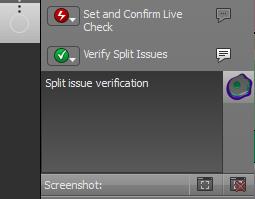
Fig. 3
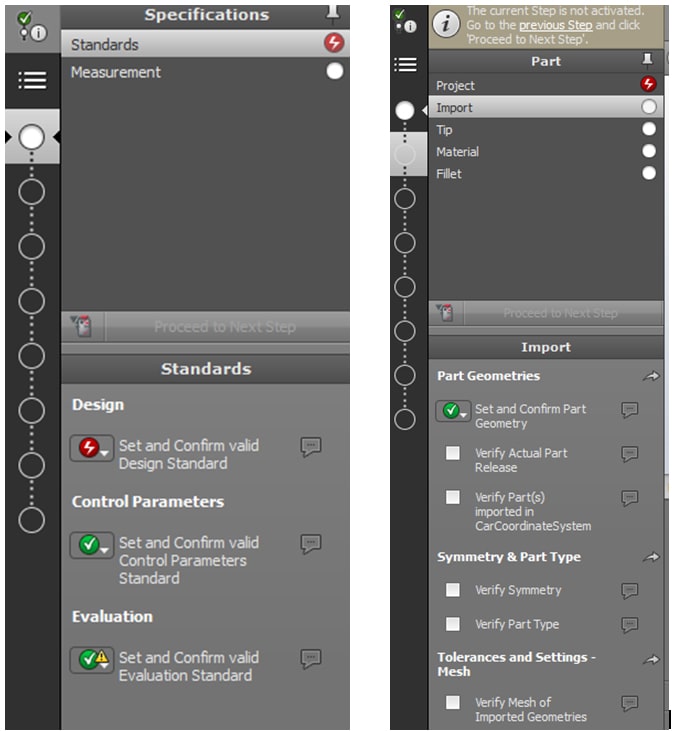
Fig. 4 & Fig. 5
Throughout the setup, it is still up to the user to ensure all steps are checked off. With this functionality, we aim to help simplify things for you and help create an official report showing you have indeed carried out the required steps along with any other points which fall under the category of “Company Standards”.
To summarize, the new Guideline functionality supplements the existing Standard functionality and aims to further close the gap between simulation and reality, as yet another step towards greater accuracy.






